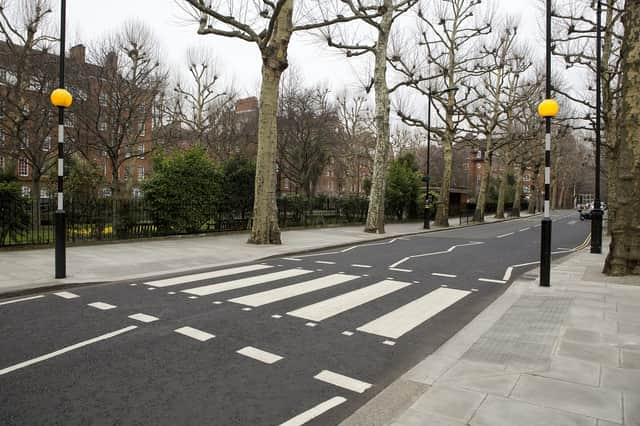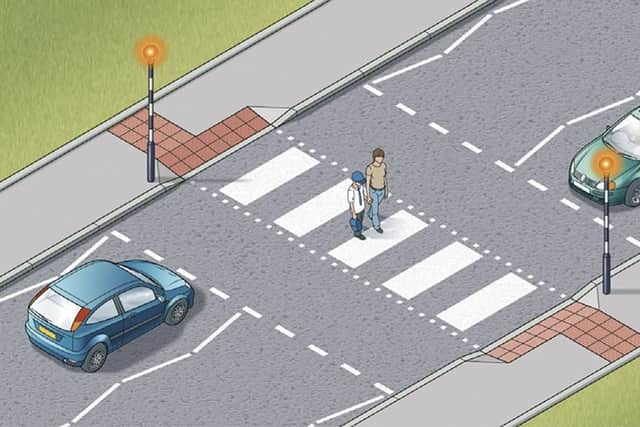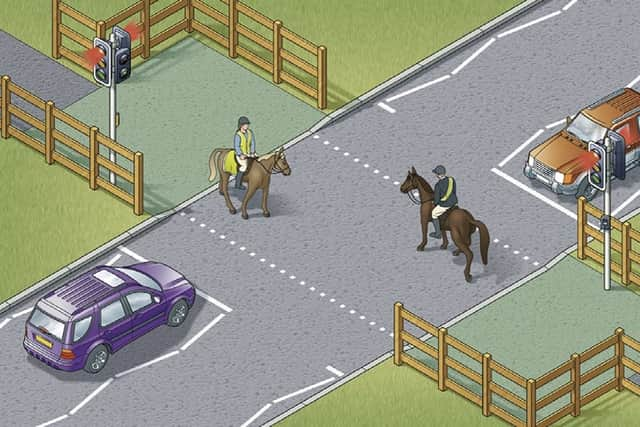80% of drivers are confused by zebra crossings: here’s all you need to know about UK road crossing rules


Eight in 10 drivers don’t know when they should give way to pedestrians at zebra crossings, according to new research which has revealed widespread confusion about the different types of road crossings in the UK.
As changes to the Highway Code aim to give more protection to pedestrians and cyclists, a poll of drivers has found many don’t understand the different types of crossings, who is permitted to use them and the rules for who has right of way.
Advertisement
Hide AdAdvertisement
Hide AdAccording to the research by USwitch, 81 per cent of drivers wrongly believe they must give way to pedestrians approaching a zebra crossing. In fact, the Highway Code states that drivers only need to stop for pedestrians who have begun crossing.
The survey also found 71 per cent of motorists don’t understand the rules for pelican crossings and 75 per cent wrongly believe cyclists have to dismount at toucan crossings.
There are currently seven types of crossings in use in the UK, including the less coming pegasus and tiger crossings. Here we run down the differences between each of them.
Zebra crossings
Zebra crossings are marked with black and white stripes on the road and zigzag lines on either side. These markings warn drivers that there may be pedestrians crossing or waiting to cross the road. They also tell drivers that they must give way to pedestrians who have stepped onto the crossing.
The Highway Code currently states that motorists MUST stop traffic for pedestrians who have moved onto the zebra crossing, but not those approaching or waiting by the side of the road. With safety in mind, it also notes that pedestrians ‘MUST NOT loiter on zebra, pelican or puffin crossings.’
Tips for drivers: Unlike other crossings, there are no traffic lights, only the Belisha beacons. As a driver approaching a zebra crossing you must be on the lookout for pedestrians who are potentially about to use the crossing. Equally, pedestrians must be sure that the approaching driver has spotted them before they attempt to cross.


Pelican crossings
These are signal-controlled crossings operated by pedestrians. Here, pedestrians are required to push the control button to activate the traffic signals and wait for a steady green figure to show before crossing with care. Only pedestrians are legally permitted to use pelican crossings, they cannot be used by cyclists (unless they dismount) or horse riders.
Tips for drivers: On approaching a pelican crossing you’ll see white zigzag lines to indicate a crossing. Drivers should look to see whether there are pedestrians waiting at either side of the road and be prepared to stop as the traffic lights may turn red shortly. As a driver you’ll see a combination of traffic light sequences at these crossings: red, amber, flashing amber, and green. A flashing amber light signals that you must give way to pedestrians who are crossing the road.
Puffin crossings
Advertisement
Hide AdAdvertisement
Hide AdThe puffin crossing is similar to the pelican crossing but is fitted with sensors than can detect when the crossing is clear to release the traffic with a green light, or when a pedestrian may be taking longer to cross the road, which will hold the traffic at a red light a little longer. Although similar to a pelican crossing, puffin crossings do not utilise the flashing amber traffic light which gives pedestrians right of way.
Tips for drivers: As with the pelican crossing, ensure you look out for pedestrians waiting to cross. Although similar to a pelican crossing, puffin crossing lights do not utilise the flashing amber traffic light. They operate just like a normal traffic light. It’s possible that a pedestrian will cross at a strange angle and not trigger the sensor so always be on the lookout for pedestrians at a puffin crossing.
Toucan crossings
Toucan crossings are light-controlled crossings which allow cyclists and pedestrians to share crossing space and cross at the same time, and work in the same way as pelican crossings. The only physical difference between a toucan and pelican crossing is that the width of the crossing is wider, to allow more room for cyclists. Unlike pelican crossings, where cyclists must dismount, at toucan crossings, they can cycle across the road.
Advice for drivers: As you would with a pelican or puffin crossing keep an eye out for any pedestrians or cyclists who are waiting to cross the road and be prepared to stop should the lights change. The amber flashing light feature is not used at toucan crossings and traffic lights operate like normal. Be aware of any cyclists who may make a dash across the road as the lights change.
Pegasus crossings
Also known as an equestrian crossing, pegasus crossings are designed for pedestrians and horse riders to cross the road safely together. They are similar to the toucan crossing, allowing two to cross together, however, they are the least common type of pedestrian crossing in the UK. They tend to be located near racecourses or horse training areas, and even feature an additional button raised two metres above the standard button for riders to reach easily.
Advice for drivers: At a pegasus crossing you’re going to encounter horses, so avoid revving your engine and making any sudden movements, which may startle the horse and cause an accident. Make sure you leave plenty of room between your car and the crossing for the horses to cross the road safely and peacefully. At a pegasus crossing there is no flashing amber light, and the traffic lights will operate like normal. Ensure the horse and rider have completely cleared the crossing before moving off, and when you do so move slowly so not to startle the horse.


Tiger crossings
A tiger crossing, also known as a parallel crossing is similar to a standard zebra crossing but is wider and features a dedicated lane for cyclists in parallel to the pedestrian crossing. They are relatively new in the UK and don’t yet feature in the Highway Code but are being increasingly adopted to improve cycling infrastructure. As with regular pedestrian zebra crossings, there are no light controls but flashing Belisha beacons to alert drivers to their presence. As with toucan crossings, cyclists are not required to dismount when using a parallel crossing.
Tips for drivers: As a driver approaching a parallel crossing you must be on the lookout for pedestrians and cyclists who are potentially about to use the crossing. Equally, pedestrians and cyclists must be sure that the approaching driver has spotted them before they attempt to cross and approach at a safe speed.
Pedestrian refuge islands
Advertisement
Hide AdAdvertisement
Hide AdA pedestrian refuge island is a raised section of pavement between two lanes of traffic moving in opposite directions. The islands normally have yellow and white plastic bollards with a blue arrow to remind motorists to keep left. Kerbs are dropped at both sides of the road, usually with tactile paving where the pavement slopes towards the road. Refuge Islands allow pedestrians to stop in the centre of the road, so they can split the crossing into two stages for each direction of traffic.
Tips for drivers: If you see a pedestrian at a refuge island, be prepared to slow down, as they could step out onto the road. For the pedestrian to cross safely, they must have good judgement of vehicle speeds and gaps in vehicle traffic. Visually impaired people, or those with other disabilities may find refuge island less easy to use compared with a zebra or puffin crossing, so drivers need to be alert.